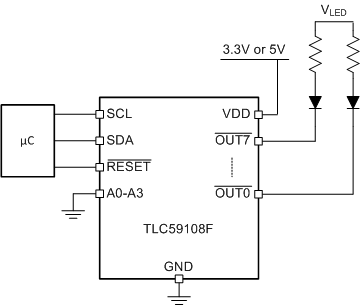SLDS162B March 2009 – December 2015 TLC59108F
PRODUCTION DATA.
- 1 Features
- 2 Applications
- 3 Description
- 4 Revision History
- 5 Pin Configuration and Functions
- 6 Specifications
- 7 Parameter Measurement Information
-
8 Detailed Description
- 8.1 Overview
- 8.2 Functional Block Diagram
- 8.3 Feature Description
- 8.4 Device Functional Modes
- 8.5 Programming
- 8.6
Register Maps
- 8.6.1 Control Register
- 8.6.2 Mode Register 1 (MODE1)
- 8.6.3 Mode Register 2 (MODE2)
- 8.6.4 Individual Brightness Control Registers (PWM0-PWM7)
- 8.6.5 Group Duty Cycle Control Register (GRPPWM)
- 8.6.6 Group Frequency Register (GRPFREQ)
- 8.6.7 LED Driver Output State Registers (LEDOUT0, LEDOUT1)
- 8.6.8 I2C Bus Sub-Address Registers 1 to 3 (SUBADR1-SUBADR3)
- 8.6.9 LED All Call I2C Bus Address Register (ALLCALLADR)
- 9 Application and Implementation
- 10Power Supply Recommendations
- 11Layout
- 12Device and Documentation Support
- 13Mechanical, Packaging, and Orderable Information
1 Features
- Eight LED Drivers (Each Output Programmable at OFF, ON, Programmable LED Brightness, Programmable Group Dimming and Blinking Mixed With Individual LED Brightness)
- Eight Open-Drain Output Channels
- 256-Step (8-Bit) Linear Programmable Brightness Per LED Output Varying From Fully Off (Default) to Maximum Brightness Using a 97-kHz PWM Signal
- 256-Step Group Brightness Control Allows General Dimming [Using a 190-Hz PWM Signal From Fully Off to Maximum Brightness (Default)]
- 256-Step Group Blinking With Frequency Programmable From 24 Hz to 10.73 s and Duty Cycle From 0% to 99.6%
- Four Software Programmable I2C Bus Addresses (One LED Group Call Address and Three LED Sub Call Addresses) Allow Groups of Devices to be Simultaneously Addressed Any Combination (For Example, One Register Used for All Call so That All the TLC59108Fs on the I2C Bus Can be Simultaneously Addressed and the Second Register Used for Three Different Addresses so That One Third of All Devices on the Bus Can be Simultaneously Addressed)
- Software Enable and Disable for I2C Bus Address
- Software Reset Feature (SWRST Call) Allows the Device to be Reset Through the I2C Bus
- Up to 14 Hardware Selectable I2C Bus Addresses so That Each Device Can be Programmed Individually
- Output State Change Programmable on the Acknowledge or the STOP Command to Update Outputs Byte-by-Byte or All at the Same Time (Default to Change on STOP)
- Maximum Output Current: 120 mA
- Maximum Output Voltage: 17 V
- 25-MHz Internal Oscillator Requires No External Components
- 1-MHz Fast-Mode Plus (FM+) Compatible I2C Bus Interface With 30 mA High Drive Capability on SDA Output for Driving High Capacitive Buses
- Internal Power-On Reset
- Noise Filter on SCL/SDA Inputs
- No Glitch on Power Up
- Active-Low Reset (RESET)
- Supports Hot Insertion
2 Applications
- Gaming
- Small Signage
- Industrial Equipment
3 Description
The TLC59108F device is an I2C bus controlled 8-bit LED driver optimized for red, green, blue, or amber (RGBA) color-mixing applications. Each LED output has its own 8-bit resolution (256 steps) fixed frequency individual PWM controller that operates at 97 kHz with a duty cycle that is adjustable from 0% to 99.6% to allow the LED to be set to a specific brightness value. An additional 8-bit resolution (256 steps) group PWM controller has both a fixed frequency of 190 Hz and an adjustable frequency between 24 Hz to once every 10.73 seconds with a duty cycle that is adjustable from 0% to 99.6% that is used to either dim or blink all LEDs with the same value.
Each LED output can be off, on (no PWM control), set at its individual PWM controller value or at both individual and group PWM controller values. The TLC59108F operates with a supply voltage range of 3 V to 5.5 V and the outputs are 17-V tolerant. LEDs can be directly connected to the TLC59108F device outputs.
Device Information (1)
| PART NUMBER | PACKAGE | BODY SIZE (NOM) |
|---|---|---|
| TLC59108F | VQFN (20) | 4.50 mm × 3.50 mm |
| TSSOP (20) | 6.50 mm × 4.40 mm |
- For all available packages, see the orderable addendum at the end of the data sheet.
Simplified Schematic

4 Revision History
Changes from A Revision (December 2011) to B Revision
- Added Pin Configuration and Functions section, ESD Ratings table, Feature Description section, Device Functional Modes, Application and Implementation section, Power Supply Recommendations section, Layout section, Device and Documentation Support section, and Mechanical, Packaging, and Orderable Information section Go
Changes from * Revision (November 2011) to A Revision